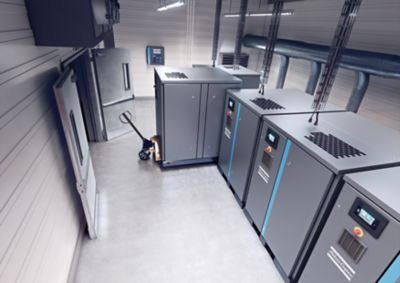January 30, 2023
Using ISO 8573-1:2010 to achieve the right compressed air quality
A world without compressed air is unthinkable. Factories would stand still, trains would stop running and ships would aimlessly drift in the ocean. But not all compressed air is the same. Some applications –food and pharmaceutical production for example – require unquestionably clean air. For others, the main goal when it comes to air quality is to ensure the reliability and lifetime of air-powered tools.
Compressed air should be filtered
First: most compressed air systems need one or more filters. That is because the air that leaves a compressor can contain a wide range of contaminants: sand, salt and sugar grains; black carbon; rust; cement and paint particles; asbestos; and bacteria and viruses. This mix can compromise your air-powered tools, your processes, and your final products. That is why filters are a crucial component of your air system to safeguard the quality and reliability of your production. But how pure should your compressed air be and what filters should you get?
Why you need to know your air quality needs
There are two main reasons why users of compressed air should always know what level of purity they need.
- Some applications are required to meet specific air quality standards. Non-compliance can result in fines or production being shut down.
- As a rule of thumb, the purer the air has to be, the more expensive it is to produce. Extremely pure air requires additional hardware, such as filters and dryers, and generating it consumes energy. Therefore, picking the right purity can save money and benefit the environment.
ISO 8573-1:2010: How you know which air purity is right for you
To the layperson, choosing the proper air purity probably seems like a daunting task. However, there is a tool that makes things much easier: It is called ISO 8573-1:2010.
That is the technical name of the international standard for air purity classes. It defines through a ranking of classes the acceptable levels of various contaminants – such as moisture, particulate, oil and other pollutants – in a compressed air stream.
While the ISO standard simplifies things, there are so many contaminants and purity classes that navigating it can still be a challenge. The brief guide below will help laypersons find their way around ISO 8573-1:2010 to determine the required air purity classes.
The structure of ISO 8573-1:2010
The ISO standard is divided into three main groups of contaminants: Solid particulates, water (both liquid and vapor) and oil (both aerosols and vapor). Each of these categories has up to ten different purity classes (eight for particulates, ten for water and five for oil).
Filtration solutions engineered to provide the best quality air
It is vitally important to the user that the compressed air be of the right quality.
The lower the number of the category, the purer the air has to be. That means, for example, that class 4 air can have more impurities than class 3.
In the case of solid particulates, the standard defines how many tiny parts the air can contain per m3. This section is subdivided further by particle size. For example, class 1 air has to contain 20,000 or fewer particles with a size of 0.1-0.5 micron, 400 or fewer particles with a size of 0.5-1 micron and 10 or fewer particles with a size of 1-5 micron (a micron is a measure of size and equals 1/1000th of a millimeter). Class 2 air only requires the air to have 400,000 or fewer particles with a size of 0.1-0.5 micron, 6,000 or fewer particles with a size of 0.5-1 micron and 100 or fewer particles with a size of 1-5, and class 3 does not even specify an amount of the first category and, beginning with class 6, the ISO standard only specifies the mass concentration of particulate in milligram per cubic meter.
In the case of water, the more stringent classes are ranked according to their pressure dew point and, starting with class 7, based on the liquid content in the air in gram per cubic meter. Specifically, that means that the dew point of class 1 air has to be at least -70°C while class 9 air can contain between 5-10 g/m3 of water and/or water vapor.
Finally, the ISO class for oil is determined by the oil content in mg/m3. Class 1 calls is required to contain no more than 0.01 mg of any type of oil, while class 4 air can have 500 times that amount (5 mg/m3).
Choosing the right filter for your ISO class
So once you know which ISO class your compressed air should meet, which filters should you get? Simply look for the ISO class when selecting a filter.
For example, Atlas Copco’s UD+ filters indicate an ISO class performance of [1:-:2]. This means they help achieve air purity class 1 for solid particles and class 2 for oil. UD+ don’t filter out moisture. Hence the “–” in the middle.
Filters and applications
Once you know the right ISO class for your application, then you can plan which equipment you need to meet the respective requirements. If you need help making the right choice for your application, your Atlas Copco representative will be happy to help.

